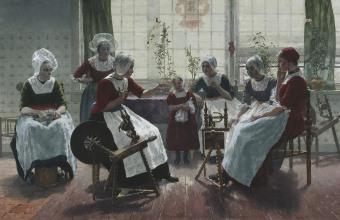
Section Branding
Header Content
Dutch-American Artistic Links Explored
Primary Content

Savannah's Telfair Museum of Art is ready to open its most ambitious exhibit ever. The long-planned exhibit, "Dutch Utopia," explores an area of art history that wasn't well researched -- until now.
The painting "Ghost Story" by Walter MacEwen might look familiar to you. Not because of its subject -- a group of Dutch maidens sewing, spinning and listening in rapt attention as one of them tells a tale.
The painting might jog memories because of the way light pours in from a window. It recalls works by the 16th Century Dutch master Johannes Vermeer.
But, "Ghost Story" is a 19th Century work by an American who lived in Holland. The Dutch maidens are normally at a museum in Cincinnati. Telfair museum curator Holly McCullough says it's a coup that the work is now on display in Savannah.
"This was an enormously popular narrative picture," McCullough says. "It represents 19th Century trends in American painting. I had to beg and plead for that one for about two years."
The exhibit "Dutch Utopia" took five years of planning and research. It explores a subject that Denver University art professor Annette Stott calls an under-studied area of art history. Stott wrote the catalog for "Dutch Utopia."
"It is the largest collection of paintings by American artists of the Netherlands that has ever been assembled," Stott says. "And that's important because it's a part of art history that's really not well-known."
The works are by Americans who lived Holland around the turn of the last Century. These Americans were searching for an escape from the urbanization of modern life.
So, their paintings run the gamut of obvious Dutch bucolic scenes. There are windmills, tulips and florid landscapes. And that's where the exhibit gets its title. Stott says, the Americans were painting a "Dutch Utopia."
"They lived at a time when the importance of art was that it was intended to be uplifting," Stott says. "It was supposed to leave the viewer a better person than before they saw the painting."
But more than painting pretty pictures -- like some touristy kitsch -- the Americans in Holland were part of a larger art movement. They were both looking back to earlier artists -- like Vermeer and Rembrandt -- and also presaging later ones.
Stott offers the example of George Hitchcock, who in the Dutch town of Egmont attracted followers of a particular style of color.
"And he was not a theoretical kind of a guy, but his students figured out ways of theorizing and codifying so that they could teach the color theory," Stott says. "And they, in the United States, established schools that taught that color theory that became part of modernism."
A day-long symposium at the Jespon Center on Friday will explore the importance of the Americans in Holland. For the organizing museum, Savannah's Telfair, the exhibit's importance is about how much effort went into putting it together. The Telfair's director Stephen High says, the 73 paintings in "Dutch Utopia" represent one of the most important exhibits from the South's oldest art museum.
"We had to borrow from some 30 museums here in the United States and another 20 or so institutions and collections in Europe, getting the loans in place, organizing all the packaging, preparation, getting the works shipped here," High says. "The other aspect is the scholarship that goes along with it, the book that's published."
"Dutch Utopia" is the Telfair's first exhibit to travel internationally. It'll travel to Holland next year. It also will show in Cincinnati and Grand Rapids, Michigan.
Tags: visual arts, Savannah, All Things Considered, Telfair Museum, Holland, Netherlands, Dutch, Stephen High, Holly McCullough, Annette Stott, Denver University, Cincinnatti, Grand Rapids
